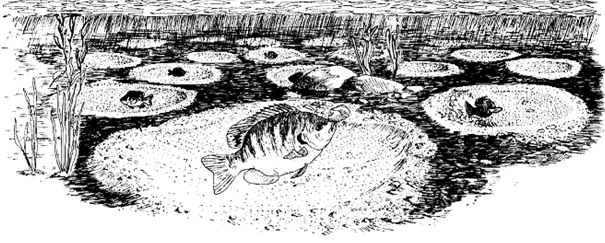Reproduction
During mating season, the dominant male Pumpkinseed Sunfish swim closer to shore and establish a nest, or a nesting territory. When the female Pumpkinseed Sunfish is ready to spawn she will enter a male’s territory in which the male with approach the female in a more aggressive manner, where sometimes the female is driven out by the male. As the female remains in the territory, the male becomes less aggressive and eventually there will be a brief courtship between the male and female and after the female with lay her eggs as the male deposits his sperm. Afterwards, female leaves the nest and the male’s territory. The female takes no part in constructing and maintaining the nest or caring for the young. It is, however, the male who takes on this responsibility. He will remain by the nest, guarding the eggs (Stacey and Chiszar,1978).

Relationships between behavior and the specific markings to the
individual have been observed in many species, including the
Pumpkinseed Sunfish. These markings act as a communication tool
between the individuals in the species. The males exhibit a red
opercular flap and a red iris. These colorings tend to develop
more intensely when the male is competing for dominance, in
respects to finding a mate. The males that are more dominant
retain these traits while it is seen that the red color fades or
even disappears in the more subordinate males. Overall the
coloration of the male is brighter while the female’s coloration
is dull in comparison. The female may also develop dark “bars”
or stripes during mating season. It is thought that this feature
may actually lower male aggression towards the female (Stacey
and Chiszar,1978).
